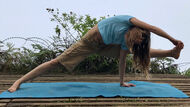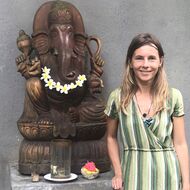Nadi Sodhana Pranayama
Nadi Balancing and Purification
It is difficult to overestimate the importance of breath, because it all starts and ends with the breath. Moreover, yogis believed that our life is measured by breath, and we are destined to make a certain number of inhales and exhales during our life span, whereas the right and conscious breathing enlarges us with the vital energy (prana) and that breath does not count. The main difference between Pranayama and usual breath is the awareness of the breath and the correct ratios. Pranayama (inhale, breath retention and exhale) as breathing technique comes before Pratyahara (sensory withdrawal) and Dharana (one pointed concentration), while being the last part of the Outer or External Yoga branch. Usually pranayama is performed in tandem with siting asanas that give steadiness. Ιf Pranayama is not practiced well enough it may impede the practitioner to dive into deeper meditative states, not only because it is difficult to attain the inner concentration, but because of imbalanced and unpurified nadis – energy channels in the subtle body through which the vital energy or prana flows. Yoga Darshana Upanishad states that impurities in the nadis are caused by low pranic energies, which, in turn, are the effects of mental cravings and exhausting or wrong lifestyle, where tamas or rajas prevail. Nadi Sodhana purifies our nadis by the process of alternate nostril breathing. In Sanskrit and Sinhala languages, the word ‘sodhanam’ means purification.
How to practice?
Preparation: Sit in steady and comfortable posture and breathe slowly until the breathing becomes even and rhythmic, while focusing on the nose tip. Then draw your inner attention to the top back of the head where a subtle sensation may arise.
We fold forward the index and middle fingers of the right hand except the ring and little fingers, and the thumb, and we pinch our right nostril with the right thumb (Vishnu Mudra). Then we slowly and deeply inhale through the left nostril and draw the prana (vital air) down filling the belly. We pinch our left nostril with the ring and maybe also with the little finger, while retaining the breath inside. After that, we remove the thumb and exhale fully and slowly through the right nostril, while ending the half set. Try to establish a rhythm, let the inhalation and exhalation follow without tension or interruption as a continuous FLOW. Do not force yourself: if it is difficult to hold your breath for a long time, exhale without any tension. The main thing is to follow, to concentrate, and to be aware of your breathing. Imagine “Now I am breathing the air slowly and deeply (together with it I draw in the vital air or prana), it flows down filling my belly and retains there, candling the inner fire”. Concentrate on Manipura or Nabhi cakra (Navel center) area because there the storage of prana is located. Then we move in reverse order, alternating fingers: with the left nostril clamped with the ring and maybe littler finger, we inhale through the right nostril, hold our breath again whilst pinching the nostrils with both fingers, and then exhale through the left nostril – this is the end of the first set.
Inhale for 16 counts, hold the breath inside the abdomen for 64 counts and exhale for 32 counts – 16:64:32 is the ratio given in Yoga Darshana Upanishad. At first, it is difficult to hold your breath for 64 counts, so you can change the ratio to 4:16:8 or 2:8:4. To feel the effect, it is worth to practice Nadi Sodhana at least 6 full sets. The best time for practicing is sunrise, sunset, noon, midnight and 3.30am in the early morning. After practice, you feel yourself revitalized and filled with vital energy (prana). Regular assiduous practice helps the yogi to achieve liberation even being in this body.

Yoga at World's End

Nada Yoga








